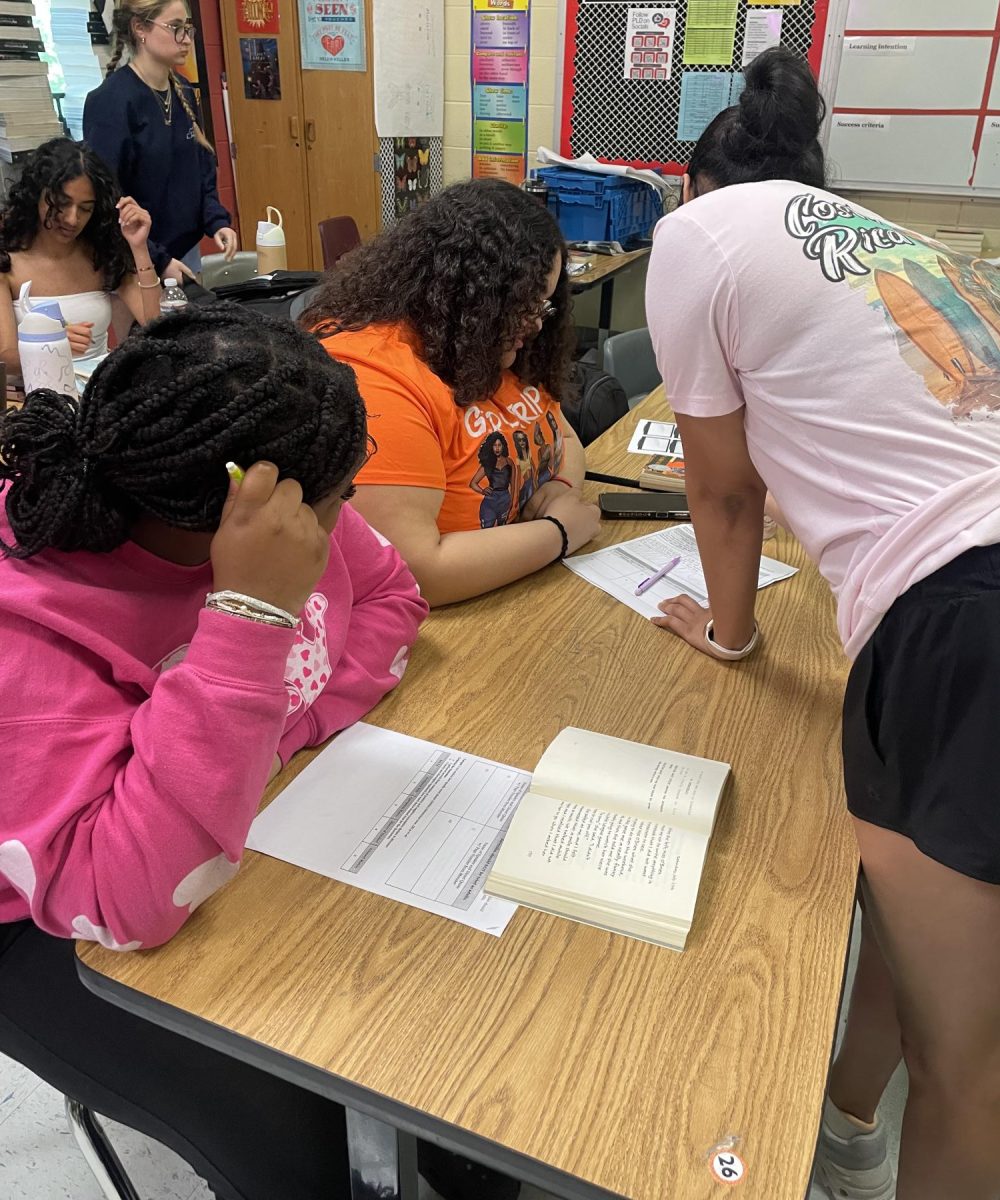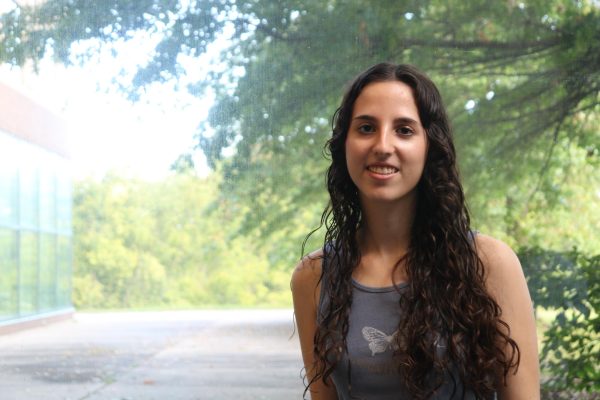As of 2020, it is estimated that 10.3% of students in the US are English Language Learners (ELLs).
This means almost 1 out of every 10 public school students in the United States is learning to speak English.
At 5%, Kentucky is considered a high-ELL-growth state—the second fastest-growing state in the nation, with the highest ELL population growth between 2000-2001 and 2010-2011 at an increased rate of 306%.
That number is even higher at PLD, precisely 8.0% (as of 2017).
As the numbers of ELLs continue to rise across the nation and at Dunbar, there is a growing interest in how these students’ day-to-day is with limited proficiency in English, and how exactly this affects their education and socialization with others. Two ELL students, senior Iliana De Leon Del Cid, and junior Alejandra Pablo Galan offered to share their perspectives on what it’s been like for them at PLD.
But first, a little context on ELLs.
How do Dunbar ELLs Learn?
There are many different instructional program models to educate ELLs, including transitional bilingual, which continues instruction in students’ native language but aims to get them to be English proficient, and dual-language, where students spend half of their day instructed in English and the other half in a different language.
At Dunbar, ELLs are educated in an ESL program (English as a Second Language) where they are taught to speak, listen, read, and write in English. ESL emphasizes becoming English proficient in order for ELL students to reach the same academic standards as students who are native speakers. ESL classes are unique in that they contain students who speak a variety of different languages so teachers must be able to work with students without knowing their native language.
However, ESL might not be the most encompassing acronym, because “English as a second language” does not accurately describe students who may be fluent in multiple languages. Other acronyms include English as a foreign language (EFL), English as an additional language (EAL), and English as a New Language (ENL).
ELL Students and Other Language Speakers
Many students at Dunbar are bilingual or multilingual. Many of these students are the children of immigrants who came to the United States, and they are referred to as heritage speakers.
Heritage speakers are speakers who grow up in multilingual homes and speak a minority language they learned there, in addition to the majority language spoken in their society. For example, Dunbar has a sizeable Hispanic population. A lot of these students would be heritage speakers of Spanish if they grew up in the United States.
This is interesting when we consider English learners on a national level because the majority of ELLs are heritage speakers– born in the U.S. and U.S. citizens with limited proficiency in English.
Dunbar’s ELLs, however, are unlike these students in that they consist of students from non-English speaking families that recently immigrated to the United States. These students are all from different countries and speak a variety of different languages, but as of 2017, the majority of them–86.1% are Hispanic and speak Spanish/Castilian.
Transitioning to a New Normal
ELLs can face countless challenges in adapting to a new normal in a U.S. public high school.
Geneva Gay, professor emerita in the College of Education, University of Washington, Seattle, acknowledges these struggles in her book, Culturally Responsive Teaching: Theory, Research, and Practice:
“Immigrant students entering the United States have to adjust to a new culture, language, style of living, and educational system. This geographic, cultural, and psychoemotional uprootedness can cause stress, anxiety, feelings of vulnerability, loneliness, isolation, and insecurity.”
Iliana and Alejandra can attest to this, as both agreed it was more difficult adjusting to a new school with the added weight of learning a new language.
Iliana believes that the most challenging part is feeling misunderstood when she speaks English.
“A veces quiero transmitir algo y no me entienden, o me entienden otra cosa.”
“Sometimes I want to convey something and they don’t understand me, or they understand something else.”
She also felt the language barrier to be the most frustrating part of adapting to an American school. When asked why, she responded:
“Porque todos aquí se comunican por el inglés. Aunque hay personas que hablan en español, pero en el fondo uno también quiere comunicarse con las personas nativas, entonces eso hace que sea un poco frustrante.”
“Because everyone here communicates in English. Although there are people who speak Spanish, but deep down you also want to communicate with native people, so that makes it a bit frustrating.”
Alejandra agreed with this idea, mentioning how a language barrier caused issues when making friendships and studying:
“Sí, también porque si uno quiere hacer más amistades, o para aprender en las materias, es un poco mas difícil para resolver como las tareas o algo así, pero es lo más complicado de eso.”
“Yes, also because if you want to make more friends, or to learn in the subjects it is a bit more difficult to resolve like homework or something like that, but it is the most complicated part of that.”
Social Interaction
Social interaction at school is crucial for every child, but even more so for students who may not have the ability to communicate fluently with other peers in the same dominant language.
Alejandra and Iliana are quick to express how they feel comfortable with their friends and teachers at Dunbar.
“Sí. De la forma que nos reciben o nos tratan,” Alejandra said. “No nos sentimos excluidas de parte de ellos.”
“Yes. In the way that they receive us or treat us. We don’t feel excluded from them.”
Iliana also echoed this sentiment:
“Te toman en cuenta con todo. No te excluyen de nada.”
“They take you into account with everything. They don’t exclude you from anything.”
This feeling of belonging is important with ELL students because of how difficult their transition often is. However, Gretchen Johnson Griffey, in her research thesis paper for Regis University: “Increasing the Social Connection between Immigrant English Language Learners, School Staff, and Peers in the High School Setting” claims it doesn’t have to be.
“If ELLs feel welcomed, valued, and connected to others, the high school experience can be a positive one,” Griffey says.
Both Iliana and Alejandra are quick to agree that they feel part of Dunbar’s school community and culture.
“Sí, te toman en cuenta en todas las actividades que hacen y ya puedes compartir con las demás personas, aunque no seamos de los mismos países podemos compartir y hacer lo mismo,” Iliana reflected.
“Yes, they take you into account in all the activities they do and you can share with the other people, even if we’re not from the same countries we can share and do the same.”
Treated Differently
Although both Alejandra and Iliana feel included in their school community and by their peers, they do see themselves being treated differently than non-ELL students.
In a 2004-5 year long ethnographic study conducted by Maria E. Franquiz and Maria del Carmen Salazar in a Northern Colorado high school, the researchers wanted to understand the factors that support or constrain the development of Hispanic ELL students’ academic identities and, consequently, their academic resiliency in high school.
Franquiz and Salazar determined that when teachers listened to students and practiced a humanizing pedagogy, it “results in their academic resiliency against all odds.”
But both Alejandra and Iliana feel that there is a significant difference between how teachers treat ELLs and non-ELLs.
“Siento que se nota mucho la diferencia en como los tratan,” Alejandra lamented.
“I feel that the difference in how they are treated is very noticeable.”
“Siento que algunas veces los maestros son más comprensivos con las personas que manejan mucho mejor el inglés, o con los nativos, que con las personas que aún no están muy involucradas en el idioma.”
“I feel that sometimes, teachers are more understanding with people who speak much better English, or with native speakers, than with people who are not yet very involved in the language.”
Iliana believes that this issue might affect her in the future.
“No es que me afecte tanto eso de que me ignoren, pero tal veces ya a la larga sí.”
“It doesn’t affect me so much that they ignore me, but maybe in the long run it does.”
They both agreed that teachers didn’t direct enough attention toward English learners. Iliana mentioned that this made it difficult when asking questions and receiving answers in class.
“No ignorados completamente en sí, porque uno también es como muy penoso para preguntar, pero si uno tiene una duda o algo así, a veces no te dejan muy en claro qué.”
“Not completely ignored per se, because one is also very embarrassed to ask, but if one has a doubt or something like that, sometimes they don’t make it very clear to you what.”
She also wishes that some teachers would make more of an effort to include ELLs in classroom activities in order to be more inclusive toward them.
“En algunas clases, los maestros sí nos encajan bien a todos, pero hay otras clases como que si no importa si uno participa o no, [pero] no es en todas.”
“In some classes, the teachers do fit us all in well, but there are other classes like if it doesn’t matter if one participates or not, [but] it’s not in all of them.”
Suggesting that teachers should try, “tal vez preguntándonos o incluyéndonos formalmente.”
“Maybe asking us or including us formally.”
So what are other ways teachers can be more inclusive toward English learners?
There are many learning strategies that teachers can adopt that have been shown to be effective ways of communicating with and supporting ELLs in the classroom. Some of these include speaking more slowly and clearly, listening more patiently, and remaining attentive to how the specific needs of ELLs might differ from the needs of other learners. By implementing these strategies, educators can not only be more effective in their teaching but can also make ELL students feel more seen and comfortable with them.
Opportunities and Disadvantages
The mission of Fayette County Public Schools is “to create a collaborative community that ensures all students achieve at high levels and graduate prepared to excel in a global society.”
With this in mind, are Dunbar ELLs given the same opportunities to achieve and excel as their non-ELL peers?
Alejandra says it really depends on what each student wants, or what their goals are. She specifically mentions the achievement gap between ELL students and non-ELLs, and how English learners have an inherent disadvantage in some aspects of school, especially with getting into higher education.
“Entonces digamos que para nosotras sí queremos ir al ‘college,’ pero aún no tenemos un inglés avanzado o unas buenas notas comparado con las personas que hablan mejor el inglés y que por eso entienden bien los ‘tests’ y todo ese tipo de cosas, pues pueden llegar a sacar notas más altas que personas que no lo hablen,” she said. “Entonces eso ya cambia en el transcurso de cómo tú puedes entrar al ‘college’ o salir bien de ‘la highschool.’”
“So let’s say that for us we do want to go to college, but we still don’t have advanced English or good grades compared to people who speak English better and who understand the tests well and all those kinds of things, well they can get higher grades than people who don’t speak it. So that already changes in the course of how you can enter ‘the college’ or leave high school well.”
We can see this achievement gap more clearly when we look at the percentage of ELLs that graduate high school compared to the total graduation rate. In the U.S. only 67 percent of ELLs graduate high school within four years compared to an overall rate of 84 percent. As of 2017, the graduation gap in Kentucky is worse, only 66.0% of ELLs graduated high school, compared to 87.5% of total graduates. Lower graduation rates lead to fewer opportunities, including fewer chances of getting into higher education.
But this gap is fueled by certain factors. Testing, which Alejandra mentioned, is one of them.
Griffey highlights how ELL students are automatically disadvantaged when taking standardized tests, many of which can be extremely important for accessing higher education.
“Standardized testing presents many challenges for these diverse students,” she said. “They may lack the necessary comprehension and vocabulary skills to show proficiency in the subject matter. They may lack knowledge about specific topics and struggle to write about these topics in their open responses.”
Recent legislation and education initiatives in the U.S. have pushed for increasing standardized testing in order to increase accountability for schools and improve student achievement. However, ELL students are at a disadvantage in taking these tests because of their language barriers and the quality of their previous educational background. Many standardized tests are heavily recommended for college applications, and by taking tests that aren’t specifically designed for their level of comprehension, many ELLs’ test scores on these assessments do not accurately reflect their curriculum comprehension and can hinder their access to higher education.
Another factor in this achievement gap is how the grading scale is applied to ELLs.
Many ELLs, simply by attending a school with a different language and cultural context than the one that they are used to will need the extra time that unfortunately the system rarely gives them. Because of their conditions, ELLs will often struggle more in school, as their ELP (English Language Proficiency) level will be lower than those of non-ELLs.
When grading ELLs, assessing their progress appropriately for their comprehension level has shown to be the most equitable way of measuring their achievement.
English Language Learners are a significant and growing population in the U.S. public school system, so it is of pressing concern that Dunbar’s students and staff continue to acknowledge and adapt to their presence and needs, in order to give students like Iliana and Alejandra the best possible chance to excel.


























Elissa • Sep 1, 2023 at 10:30 PM
I’m very very happy you guys added the disadvantages and actually talked about it. As an ELL student myself. I’m arab and I speak perfect English. My grandma came from Jordan to live in Kentucky (which is here) and my dad moved here from Jordan). When I was young my mom signed a contract because I wasn’t really that good at speaking and was kind of distractive. In elementary school a teacher would pull me out of class and I would get so mad. I would get put in reading intervention in middle school. Every year the test got harder. They they put me back in my freshman year then my sophomore year so I got out of the program but still forced to take the test. I was lied to when I thought I won’t test at the end of my sophomore year. The state is a bunch of racists idiots and have nothing to do but just sit there and stay lazy.